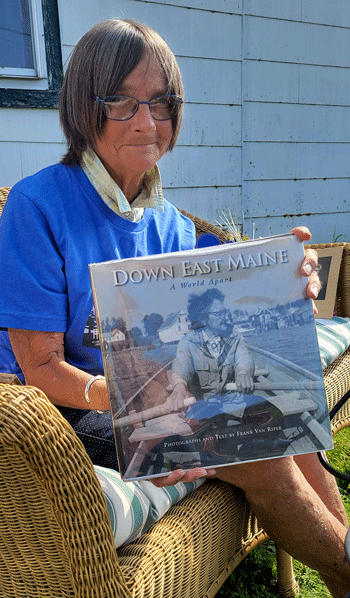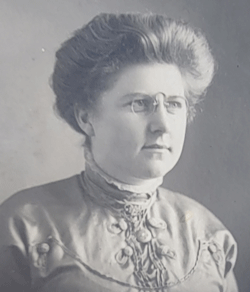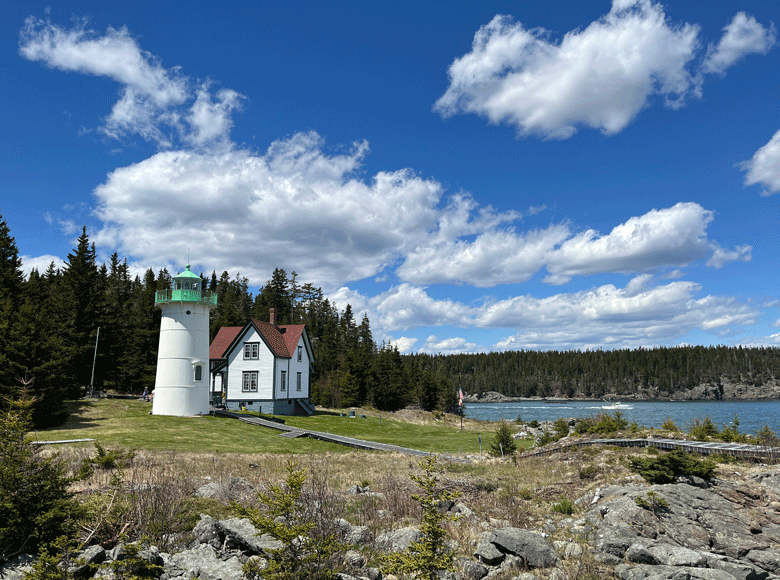Lighthouse keeper Willie Corbett knew Velma Johnson was the woman for him when she arrived for a visit in a bosun’s chair strung between a ship’s mast and the island holding Saddleback Ledge Light.
“He thought, ‘If she can handle this, she can handle anything,’” laughs his granddaughter, Delia Mae Farris, retelling the story. “He called that station ‘nothing but a damned bare rock.’”
That might be an apt description of Saddleback Ledge Lighthouse, which warns mariners of danger from its perch atop a quarter-acre of granite in the deep waters between Isle au Haut and Vinalhaven. But there were dangers for the lighthouse keepers, too. Once, after returning to Saddleback from leave, Corbett found his metal cot turned on its side and bent to the shape of the wall.
“An enormous storm had struck, and the sea had crashed in through a window—that’s power. Papa really became very respectful then. And probably very quickly put his name in to go to the next lighthouse,” recalls Farris, again laughing.
“The lighthouses are helping people but we need to help the lighthouses, too.”
—Bob Trapani
Corbett was serving at a series of what were known as “stag” stations—where women were not present—like Saddleback, while he courted Velma, having joined the U.S. Lighthouse Service in 1908. And as the daughter of a lighthouse keeper herself, Johnson was an apt match. The pair married and had eight children together, including Farris’ mother Ruth. They raised their family on the 15-acre island in Cutler, keeping the Little River Lighthouse from 1921-1945.
Lighthouse people are hardy, says Farris, and they’re also good storytellers. Today she and her Corbett cousins do their part to keep their family lighthouse stories alive. Many still reside in Cutler, where in the 1990s they met a kindred spirit who also moved to Cutler because of the lighthouse and who worked, maybe more than anyone, to keep lighthouse stories alive.
“Tim [Harrison] thrived on them. He was so excited by lighthouse stories, his enthusiasm was boundless. How could we resist it when he said, ‘May I come and sit down with you?’ recalls Farris. “‘Of course, Tim.’ And the stories would roll with our family.”
Harrison died Aug. 19, leaving a legacy that includes more than 30 years publishing stories in Lighthouse Digest magazine, and in 14 books about lighthouses, alongside extensive preservation and advocacy efforts and the founding of the American Lighthouse Foundation which, in 2007, became the first nonprofit in New England to obtain ownership of a Maine Lighthouse—the Little River Light in Cutler.

Harrison had an ear for lighthouse stories, recording the facts, the tragedies, and the whimsy of lighthouse life, too. In his book, Lighthouses of the Sunrise County, Harrison recounts the tale of a Corbett family cow who never adapted to island life “…and kept swimming to the mainland, so keeper Corbett had to go and fetch him and bring him back to the island,” wrote Harrison. “After a few times doing this, Corbett gave up, and the cow spent its remaining years on the mainland.”
As a child, Harrison fished next to the Holland Harbor Lighthouse in Michigan, and in 1989, he and his wife, Kathleen Finnegan-Harrison, traveled to visit Maine lighthouses, and eventually relocated to Cutler.
“It just was the perfect place for him to be because he was surrounded by people who were still alive, who knew all the stories, and could look at the photographs and say, ‘Oh, we can tell you about that one,” says Farris.
Harrison was devoted to preserving the Little River Lighthouse. Built in 1847, in 1998 it was listed as one of Maine’s ten most endangered historic properties. Having read about Harrison’s preservation efforts online, in 2011, Bill Kitchen asked if he could live there and work on the lighthouse while raising money and awareness for its restoration. Harrison said yes.
“Tim knew more about lighthouses than anyone else on the planet, and not just Maine lighthouses, lighthouses across America, and around the world,” says Kitchen, noting the positive impact Tim and Kathleen’s tight working relationship also made on their work with lighthouses.
“It is rare to see a couple so dedicated to a professional mission,” Kitchen says.
Today, the Little River Light still shines at the mouth of Cutler Harbor, and visitors can stay in the beautifully-maintained Little River keeper’s house through an overnight stay program.
“For the past nine years our caretaker Terry Rodin and his wife Cynthia have entertained guests from all over the world,” says Bob Trapani, executive director of the American Lighthouse Foundation, which still owns the lighthouse. “It’s just a little island paradise, and you can just get away from the world.”
In 2009, the American Lighthouse Foundation started Open Lighthouse Day, which took place this year on Saturday, Sept. 9. Nineteen Maine lighthouse towers were open to the public, as well as some keeper’s houses, the Maine Lighthouse Museum in Rockland, and the Maine Maritime Museum in Bath.
Open Lighthouse Day was founded, says Trapani, to bring attention to the need to preserve Maine’s lighthouses, to shine a light on the Coast Guard’s involvement in keeping the lights and horns working, and to showcase the beautiful places where they’re situated.
“We live in a digital age, where everything is social media, and lighthouses can sometimes be seen as static, but step inside one and it’s almost like you get to go back in time,” says Trapani, also the author of several lighthouse books, including Gleams & Whispers: Maine’s Lighthouses and Their Allure, released this year.

“Today we have GPS, and all these other digital technologies to guide boats. But there’s still something about a lighthouse, the fact that it sits there, it doesn’t move, you can always rely on it if you need it.”
There are 66 lighthouses in Maine, 55 of which are still active today, and 36 still have foghorns. The lights and horns are maintained by the Coast Guard, though the structures are maintained by other entities. Those entities can use a helping hand to continue their important work.
“The lighthouses are helping people but we need to help the lighthouses, too,” says Trapani. “We want to carry these forward, and the only way to do that is that people who care about them can give the lighthouse some of their time, or talent, or money, to help keep it standing there and gifting it to the future.”





